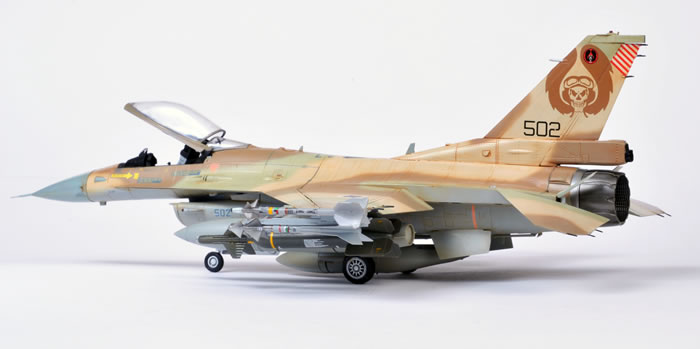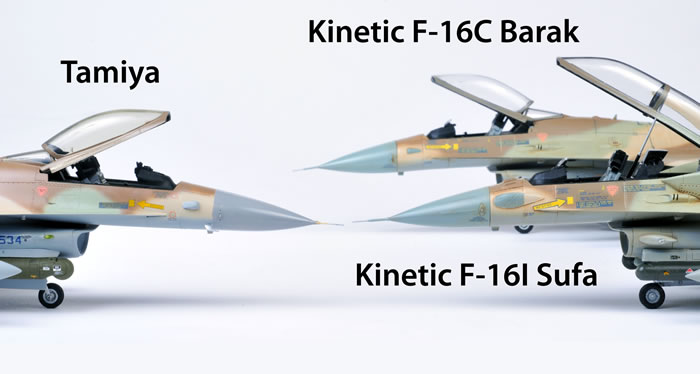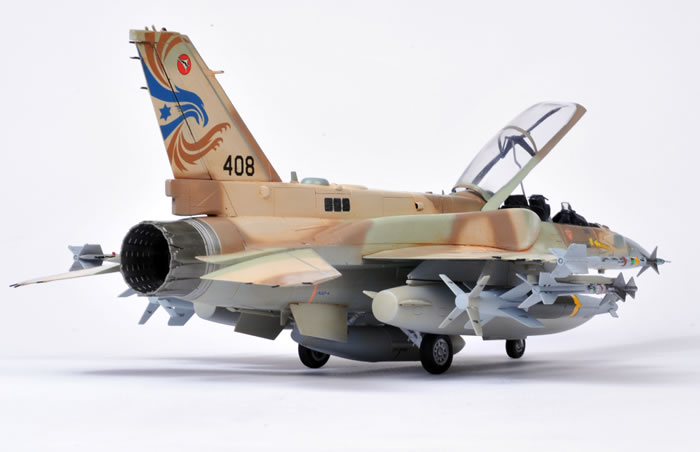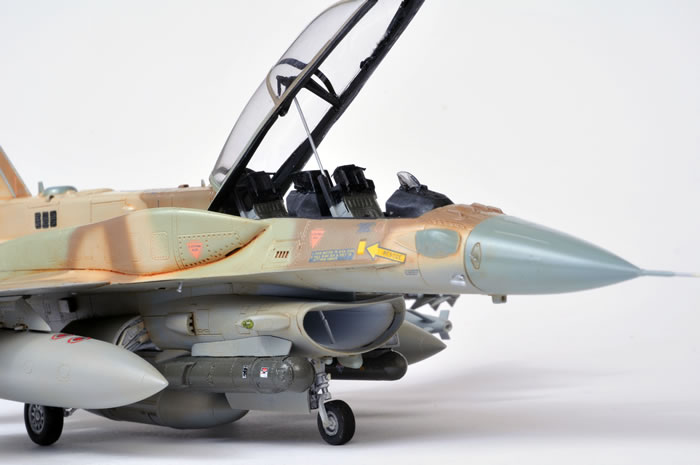Kinetic's 1/48 scale
F-16C Barak & F-16I Sufa
by Mick Evans

|
Lockheed Martin Israeli F-16I Sufa |

HyperScale is proudly supported by Squadron
Kinetic’s 1/48 scale Barak and Sufa kits feature at least 70% of parts in common with each other as detailed in my in-box review, which appears elsewhere on HyperScale.
Now that I have finished building the Kinetic Barak and Sufa kits, I can make some first-hand comparisons with the Hasegawa F-16D that I converted to a Brakeet, and the Tamiya F-16 that I built as a Barak.
Single-Seater Comparisons
Much has been made of Kinetic’s nose droop, lower fin parachute/ECM fairing and panel lines. Lining up all three kits, there is a small but noticeable difference in the nose droop on the F-16 single-seat Barak when compared to the Tamiya and Hasegawa single-seat kits. The Kinetic single-seat F-16 has about 1mm more droop than the Tamiya kit, which in turn has about 1mm more droop than the Hasegawa kit. I had read that the nose is very SU-27 Flanker like in its droop and while this may be noticeable to those who intimately know the F-16 through working around the aircraft, it is apparent when sitting it beside a Tamiya kit but it is not all that obvious when sitting solo.

The panel lines look very similar to the Tamiya kit under a coat of paint - Tamiya’s being slightly sharper - although there is some difference in the location of some panels. On comparing the Kinetic Barak to the Tamiya kit and many photos, the ECM/para faring at the base of the fin on the Kinetic kit is too wide, but it is also too wide on the Tamiya kit of which I have heard no criticism. The width of the Tamiya kit fin base and the Kinetic kit fin base is almost identical, and this can be easily fixed with careful sanding gradually reducing the fairing from where the leading edge of the fin joins back to the rear.

Overall, sitting the two single seat Baraks (Tamiya and Kinetic) side by side it is difficult to pick the difference. Tamiya’s is slightly finer in panel detail and displays a little less nose droop.
Kinetic Sufa Compared
The Kinetic Sufa is another story.
It would appear that Kinetic has fixed the nose droop on the two-seat kit. It has identical, if not a little less, droop than Tamiya’s.

In my opinion, this kit has only two problems. One is minor and the other is provisional. The first issue is that the fuselage conformal tanks require a bit of trimming and dry fitting to achieve a good fit.
Secondly, the Sufa commonly carries two Israeli-built 600 gallon tanks with a modified wing pylon, which is not supplied by Kinetic. Fortunately, Hasegawa’s 1/48 scale Mitsubishi F-2 has similar tanks included so, viola, my Sufa was fitted with these. I originally thought that I could modify a Hasegawa F-15 600 gallon tank but alas the rear of the tank narrows down too quickly and is quite noticeable, so my F-2 tanks were fitted to the Sufa instead.
The Kinetic kits certainly have much better wheel well detail than either the Tamiya or Hasegawa offerings, and only the Aires wheel well detail sets have more. This may be seen in my Hasegawa two-seat converted to a Brakeet.

With all four kits on the table during the photo shoot it was difficult to pick the difference.
For me, the principal factor in favour of the Kinetic kits is all of the options and the huge detail. The downside is the extra work to assemble the Kinetic kit. For some reason, this kit had reverse knock out pins that are actually protrusions on some of the parts. These are a bonus on external visible surfaces as you can trim them off and sand without losing surface detail unlike the usual depression on other kits caused by mould knock out pins that have to be filled and sanded and sometimes these are in very difficult but highly visible positions. The protrusions are present on the inside surface of every curved surface such as fuselage, fuel tanks, bombs etc, and they must be removed before assembly can begin.
The canopy locating pins for the open position are a treat, locking the canopy in the correct open position without having to be propped while the glue dries.
The decals went onto the Kinetic kit very nicely and snuggled down into the detail very well.
My biggest issue with the kit was the delicate anti static wicks on the ailerons and tail surfaces and the ejection seats. Also, the ejection seats are difficult to assemble and require some work, and they needed to be trimmed in width to fit into the cockpit.
Purists will always criticise minor inaccuracies, but I am yet to see a faultless model kit and I have been very happy to build and display these Kinetic 1/48 scale F-16s.
The key to this kit for me is that the detail is nice enough not to warrant any after marked details to replace the wheel wells, cockpit or engine nozzle. In fact, the engine nozzle detail is one of the best that I have seen.
I think that the Kinetic single-seat F-16 has been disproportionately criticised considering the angle of the nose droop, which can be fairly simply adjusted during construction. In the case of the Sufa two-seater, the nose droop seems to be just fine without any modification.

We should also keep in mind that Kinetic’s only competition for a two-seater 1/48 scale F-16 straight from the box is Hasegawa’s offerings, which are quite basic in detail.
I know this will probably prompt a Forum thread on kit accuracy but show me the perfect kit… (although I may be building it now, but that will be for another article). People will have opinions and this is my view, right or wrong, having had the benefit of building four kits from Tamiya, Hasegawa and Kinetic in close succession.
With their high level of detail in the cockpit, wheel wells and exhaust; plus all of the weapons, tanks and options supplied in the kit, I think that Kinetic provides the best value for money for any late model 1/48 scale F-16 kit.
It certainly looks great when finished too!
Thanks to Lucky Model for the review kits

Model and Text Copyright ©
2009 by Mick Evans
Images Copyright ©
2009 by Brett Green
Page Created 9 July, 2009
Last Updated
10 July, 2009
Back to
HyperScale Main Page |
Home
| What's New | Features | Gallery | Reviews | Reference | Resource Guides | Forum |